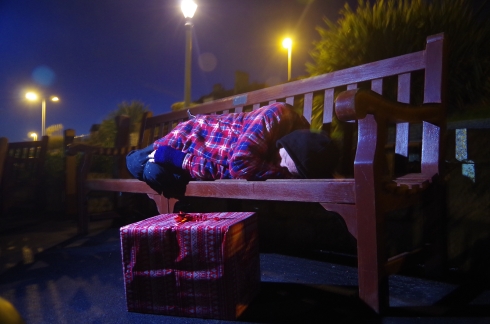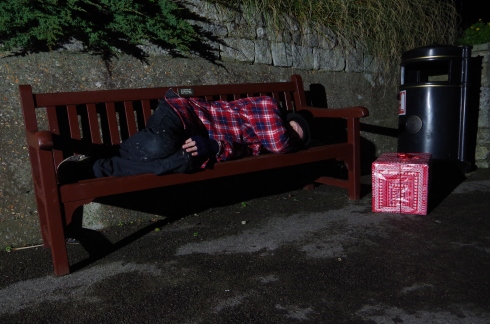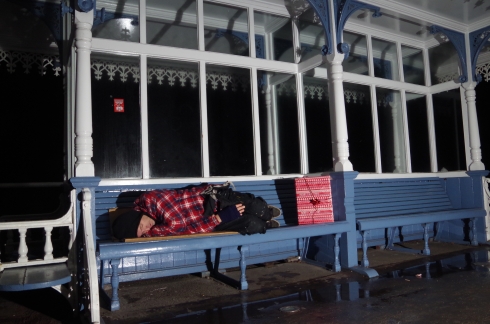Rationale
Narratives and mythologies are stories that are woven deeply into the fabric of our culture that they function as subconscious codes, which affect our attitudes and behavior. Subsequently a photographic narrative uses these codes to communicate ideas, through a single image or in a series of interconnected images to illustrate or communicate an idea or a story.
Unit 5: To enable the candidate to fully integrate research, ideas and methods within the context of a chosen art or design subject effectively.
Unit 6: To enable the candidate to develop skills with which they can make best use of appropriate progression opportunities.
Key points to think about when creating a narrative:
- Firstly, what contextual research may inform your work?
- Secondly, how will an audience within contemporary visual culture read your work?
-
Thirdly, what is the story you’re trying to tell?
“For all the talk of my pictures being narratives or that they’re about storytelling, there’s really very little actually happening in the pictures. One of the few things I always tell people in my pictures is that I want less – give me something less.” Crewdson 2014.
In the quote above Crewdson explains that sometimes the most imaginative stories created are more effective if they are simple and told without revealing too much information, allowing the viewer to make their own narrative through their own reading.
Assignment
For this project we are able to build upon our previous ideas of Visual Storytelling through the documentary project, as well as theory lectures. ‘The narrative’ is an opportunity to be subjective rather than objective and have complete control over the outcomes. We are able to tell as story through a series of images or even just a single image which may have more of an impact.
We should consider the different approaches to structuring a narrative by considering the following moments: exposition, conflict, climax and resolution. If one were following a classical structure, then the key stages in structuring a narrative would include: introducing the location, giving the story a ‘face’, letting people tell their own story, contextualizing the story.
Exploring and exploiting the photographic process and documenting this sketchbooks may help to develop a way of working that enhances visual story telling. Being playful through experimenting with analogue to refine visual strategies may add an extra interest or aesthetic to the story telling.
Final outcomes
No limit to the amount of photographic outcomes
Digital presentation of final images as JPEGS
final images saved as TIFF files to be printed
- Project Launch Presentation:
- Evaluation of the project Launch- 5/12/16
The project launch was really useful as it gave me an in depth overview of what narrative photography is, and the different types of approaches to creating a narrative. In the presentation, Matt underpinned the four main narrative approaches; Fashion narratives, open narratives, documentary narratives and conceptual narratives. This was really useful in seeing which area I’m most interested in and what area I think would create an impacting outcome.
Fashion Narratives– typically steals from myths and fairytales. The narratives rarely make sense but are visually enjoyable, similar to music. However, a styled narrative might be more versatile through particular makeup and prop choices to create a certain type of mood to the image.
Examples:
Alex Prager
American art photographer and film maker, Alex Prager creates narratives in her photographs by primarily using staged actors, models and extras to create “meticulously designed ‘Mise en scene’ often described as film-like and hyperreal. She is known for her cinematic use of colour and vintage Hollywood aesthetic. Her fashion collection Eve, 2008 (shown below) portrays a sense of surrealism as she takes her cues from pulp fiction, the cinematic conventions of movie directors such as Alfred Hitchcock, use of birds. Resembling movie stills, her unnerving photographs—crisp, boldly colored, shot from unexpected angles, and dramatically lit—feature women disguised in wigs, dramatic makeup, and retro attire.
Quote from Alex Prager:
“I find my inspiration in the city of Los Angeles,” she explains. “It’s a strange picture of perfection—but there is an eerie monotony that creeps in. It can slowly drive a person crazy, that sense of unease under the surface of all this beauty and promise.”
Populated by seductively stylized women. She constructs ambiguous scenes weighted with the uneasy expectation of impending danger. She also References to the films of Alfred Hitchcock and David Lynch and the photographs of Cindy Sherman and Gregory Crewdson abound in her work.
Open Narratives– a piece of work that has no singular answer and often invites a question to the viewer. It provides a collaboration between the viewer, enabling that to create their own story based on their own reading of the image.
Example:
Gregory Crewdson




Gregory Crewdson knowingly references film genres and theories around the ‘pose’ and the ‘decisive moment’, using film crews and equipment to stage the Photographic ‘event’. He uses multiple sources of lighting to enhance his images and visual storytelling as well as creating a cinematic feel to his images. As shown above he takes his inspirations from artists such as Edward Hopper’s painting, ‘A woman in the sun’ and recreates the idea in his own unique style.
In Beneath the Roses, anonymous townscapes, forest clearings and broad, desolate streets are revealed as sites of mystery and wonder; similarly, interiors become the staging grounds for strange human scenarios. Crewdson’s scenes are tangibly atmospheric: visually alluring and often deeply disquieting. His style of working cleverly creates an open narrative leaving the viewer to decide what the narrative is based upon their own interpretations.
Documentary Narratives- Documentary Photography often crosses the border with narrative work, expressing very subjective personal views of the photographer.
Example:
Martin Parr
Bad Weather, Martin Parr’s first photo book, published in 1982, featured an essay by the BBC’s longest-serving weather forecaster, Michael Fish. The series features 56 images shot in Britain and Ireland, of locals caught in inclement meteorological conditions. The photographer took the black-and-white pictures in the 1970s and early 1980s, sometimes using an underwater camera and flashgun, since his preferred device, a Leica M3, wasn’t sufficiently rain proof.
Conceptual Narratives- Fine art narratives express the ideas and beliefs of the artist and are therefore conceptual.Structures used are often based around the human condition (ontology) an global issues that affect us all, news current affairs etc.
Example:
Chino Ostuka

Narrating the past and present simultaneously, japanese photographer Chino Otsuka documents her cultural identity, ideas about displacement, and international travels through a series of photos that present her adult self, standing beside an image of her as a child.
‘the digital process becomes a tool, almost like a time machine, as I’m embarking on the journey to where I once belonged and at the same time becoming a tourist in my own history.’,
Personally, I feel this idea is really unique and invites the viewer to imagine what might have been, and provoke a poignant awareness of the brevity of time. The use of materials in this series (old snap shots) digitally manipulated to produce a new image is something that I may wish to explore in my project. This would fulfil Unit 5 of the brief.
Evaluation
I feel that an open narrative would really be intriguing for the viewer as it leaves them build their own story of what they believe is going on in the image. Telling a story subtly is sometimes more effective than giving too many obvious clues as to what the narrative is.
Digital Workshop with Lee Harper – 6/12/16
In the workshop Lee explained how we must correctly edit and prepare our files ready to be submitted for printing. He showed us the order of editing our images in both Adobe Lightroom and Adobe Photoshop, and how we must save our final images as TIFF files before printing.
I recorded my notes in my journal to refer back to when needed. However, here are some key points of the stages we must carry out before printing.
Lightroom:
- Adjusting the White Balance – making things that shouldn’t be colourful more colourful, using the eyedropper tool to select a specific colour.

2. Camera Calibration profile– adjust to the point at which it looks best.
3. Brightness adjustments– Exposure/shadows/highlights/whites/blacks/contrast
Tip: when adjusting highlights and shadows move the slider quickly to notice visually the changes at each point.
4. Crop and straighten– ensuring the horizon is level. This can be adjusted using the angle tool (spirit level) and clicking on the part which needs straightening. The aspect tool can be used for cropping.
5. Lens corrections– selecting the make of your lens and selecting remove chromatic ablation and enabling profile corrections will make the the content in the image more in focus.
6. Transform– using post crop vignetting will make sure the edges are the correct darkness.
7. Detail– adjusting the sharpness of the image will ensure for a higher quality print.
Final Stage: Send to Photoshop
Preferences- external editing- Adobe RGB/16 – 360ppi
Photo- edit in- Open as Smart Object in Photoshop.
Retouching in Photoshop
- Removing dust– spot healing brush
- Remove distractions– Clone stamp tool
- Creative sharpening– Actions- Margulis PPW Actions- Sharpen 2015.
Lee created a template of three folders demonstrating the best way to save our images by separating the original files, edited files and print files, as shown below.
Evaluation:
Overall, this workshop was really useful as we were able to see Lee visually demonstrate how each step improves a final image. I learnt how different tools are used to create different effects such as the spot healing brush as well as how to save our files to the correct size and resolution ready to print.
Theory Lecture with Tim Edgar- 6/12/16
Identifying Contexts and their Influence on Art, Design and Media Practice
A range of contexts profoundly influence the production of all Art, Design and Media practice, and its subsequent interpretation.
When producing aretfacts such as a painting, a film, a book, or a piece of jewellery a whole range of contexts are brought into play at all stages of production.
Identifying what these are and how they can be exploited is a fundamental aspect of the creative process.
Established practitioners are profoundly aware of how they can exploit such contexts to make their work more successful.
contextual-notes– I made a mind map of the key areas explored in the lecture,
Evaluation and Reflection
This lecture was really useful as it gave me a clearer insight into the different contextual areas that can be brought into practice within making a single image. I made me more aware that obscure contexts such as science can be integrated into work even though initially it seems more academic and unrelatable to art and design. I hope to put some of the contextual factors into practice in order for my outcomes to be more refined as narratives use context as an important part in telling the story.
Second part of the lecture
For the second half of the theory lecture Tim went into detail about Semotic signs which we subconsciously notice within an image, in order to identify the different layers of meanings.
- Indexical meaning– a sign that has a direct relationship with the subject matter.
- Iconic meaning– a sign that resembles an object but has no real connection.
- Symbolic meaning– no literally relationship with its subject, we often refer to symbols as imaginary or myths.
Example- A rose.
Indexicallity: the colour red.
Iconicity: bears a close relationship with gardening.
Symbolism: Love, affection.
‘Photography is always indexically related to the subject matter’.
This quote suggests that a subject has to be present in front of the photographer for it to be present in the image.
In the lecture, we also gained a clearer insight into four different theories that we could take inspiration from; the real, surreal, neural and hyperreal. In the link below I have made a mind map illustrating the key ideas underpinning each theory.
My Initial ideas
- The everyday journey- candid photography of strangers- where are they riding? – Inspiration- Cindy Sherman- Bus riders, Tom hunter-travellers.
- Lifestyle change- dependence on technology- people sat on their phones waiting for a train, sat in Starbucks on their phones.
- Stereotypical role of a Woman’s role- cleaning, ironing, cooking. – Inspiration- Cindy Sherman- Kitchen Photography.
- obsession culture- betting, smoking, lottery, shopping.
- The everyday journey used as a location for a fashion shoot- Inspiration- Glen Luchford- Gucci SS16 campaign, 2015.
- Focus on using props- odd hats, bags, to add a sense of surrealism- Alex Prager.
- photographing abandoned objects on a train.
Narrative Photography Tips – I used this website as reference on ways and techniques when making a photographic narrative.
Initial Idea:
My initial idea is to create a fashion narrative through using various props that may help to tell a story. I wanted to take the shoot on location, perhaps at a train station, inside the carriage, at bus stops, and inside buses. I thought that this would make my project personal to me as I use these transports daily to travel to university, therefore almost a documentary of my own everyday journey.
I made a Pinterest page to gain inspiration and ideas for the project.
Group tutorials with Matt Theodore- 7/12/16
The group tutorials with Matt were really helpful as we were able to discuss ideas with one another, offer opinions and provide useful research or key Photographers that may help with peoples projects. Talking as a group helped me concentrate on what areas of the project might work and what needs developing or improving upon. It stimulated me to make an action plan and be focused on my aim for the next week.
Key areas of discussion:
- focusing on particularly interesting accessories or props.
- Perhaps looking into basing the project simply on objects rather than fashion too to make it more realistically achieveable in the time frame allowed.
- looking at random objects that people leave on trains- lost property.
- Taking the shoot on the train- inside the carriage, or the train acting as a backdrop.
- Suggestion from Lee Harper- researching into the West Anderson H&M 2016 Christmas advert as the film is set looking through the carriages of a train.
I watched the advert on Youtube and it gave me a few ideas from different camera angles I could use in my shots (shooting through a window and an over the shoulders shot). The one thing that drew my eye in the advert was the presents left in each carriage, however the subjects placed next to the presents are oblivious they are there. This actually triggered my development of ideas to a slightly different area.
My Final Idea Proposal:
I decided that due to the time constraint of two weeks, I wanted to ensure my idea is simple to make my project more realistically achievable. Although I wanted to base my project on a fashion narrative, I found it difficult arranging and relying on different models for my shoot in just a single weekend.
Therefore, my idea is to photograph a christmas present left in random locations next to people whom may be not be fortunate enough to receive a present this Christmas. I wanted the narrative to be current and relatable to the little things we often forget about during christmas time.
What is involved in telling a story?
As part of my research I looked at Documentary Photographer, David Campbell, who focuses on visual storytelling within his work. After looking a narrative article which was posted on his website, I identified the key points which should be took into consideration when making a narrative image.
Narrative stories will also likely have within them the following moments:
Exposition– a comprehensive description and explanation of an idea.
Conflict– onflict is an inherent incompatibility between the objectives of two or more characters or forces. Conflict creates tension and interest in a story by adding doubt as to the outcome
Climax-The climax or turning point of a narrative work is its point of highest tension and drama, or it is the time when the action starts during which the solution is given.
Resolution– Resolution is the part of the story’s plot line in which the problem of the story is resolved or worked out
Key stages of a classical structure:
- introducing the location
- giving the story a ‘face’
- letting people tell their own story
- contextualizing those stories
- following a dramatic form
I am most likely going to be using the classical structure to create an open narrative for the viewer.
“If you were looking for the least narrative medium ever conceived, you would be hard-pressed to find a better candidate than photography”.
http://www.photo-mark.com/notes/storytelling-photography-considered-harmful/
Considering the presentation of a narrative story
For this project we have the freedom to either convey our narrative in one single image or in a series of images. In order to help make my decision I researched into the effect between each.
Wendy Steiner believes that a narrative can be conveyed in a two-dimensional image, but we almost never see it today. In her essay, Pictorial Narrativity (published in Narrative Across Media, The Languages of Storytelling), Wendy Steiner shows one example:
She states that it’s unusual for a single image to tell a story, but it has been common throughout the history of art for an image to imply a story or remind the viewer of a story they might already knows. A classic example:

The painting above demonstrates a ‘story telling’ image because of its close relationship with a story. The audience can identify the story from the symbolism and their own knowledge of the story. However, the painting may also be read from an audience unfamiliar of the story and therefore have no real connection with what the story is.
Theory based extract taken from Photographer, Mark Meyer.
Ideas and reflection for presentation
An area that I felt I needed to improve upon from my last project is the ability to refine my ideas down to a minimal amount. I feel that sometimes less is definitely more impacting than several images that may be too much for the viewer to identify what the narrative is.
Diptychs and triptychs are layouts which are often used for photographic storytelling. They present two or three images which can be identical or they can be polar opposites to show opposition or contrasting ideas.



Presenting my images as either a photo sequence, Diptychs or Triptychs may be a way of communicating a clear message or narrative to the viewer.

Above is an example of a photo sequence to hell narrate a story. The sequence tells a narrative story of a regression of evolution, transitioning from an artificial office environment to a natural area full of plants and nothing man made.The subjects becoming less clothed throughout as the environment changes reminds the viewer that humans are part of the earth and as susceptible to changes as everything else on the planet. The sequence also has biblical references as the figures take the form of Adam and Eve. The figures are shot from the viewer’s eye line, making it easy to relate to them as it puts us in the same position as them.
The Photographic Essay

Above is an example of the photographic essay, a sequence of shots comprising of different points of view, helping to build up a message or story in the viewers head. The varrying shots are known as the following;
- Establishing shot – The place where things happen (setting the scene)
- Environmental portrait – People/person in action, photographed in incidental way (illuminates the subject’s life and surroundings)
- Relationship – How two people relate
- Formal portrait – Looking at camera
- Detail shot –Important detail/s to the story (close up)
- Full stop – An image that brings an ending/makes a point comment to close proceedings

Paul Graham, A Shimmer of Possibility
I looked at Paul Grahams sequence of images as the way he displays the series helps to underpin what the story is. The images for this collection are fairly simple and that way he provides a vivid glimpse into unheralded moments in the lives of individuals Graham encountered on his travels. Within the series he photographs a woman eating a take-out meal or a man waiting at a bus stop. He transcends its nominal subjects and describes aspects of life that, while ordinary, are imbued by the photographer with affection and curiosity. a shimmer of possibility is a “call for attention to the brief, indefinite intervals of life”.
Research
For inspiration, I created a second Pinterest Board to develop upon my own ideas. I focused particularly on photography based around homeless people and what types of poses would be best and various locations I could shoot at.
Prior to my shoot, I researched ways of creating a narrative to ensure that my shoot would cover the key concepts for good storytelling.


These tips will be useful and I will take it with me for reference during my shoot.
Gregory Crewdson



Plan for first shoot
For this project I am going to be shooting on location and at night, as I feel this will add more of an atmosphere to the images. I will hire out Metz 45 CL-4 Flash kit which is portable, meaning it will be suitable for my using on location. I hope to take my inspirations from Gregory Crewdson’s cinematic style of practice, using lighting to add drama, tension and suspense to his images. I am going to make the prop (present) out of an old box to be used in my images and scout for locations which may be suitable. The subject matter of photographing a homeless person is quite discomforting or may be seen as disrespectful. Therefore, I am going to use my dad to ‘act’ as a homeless person. This will ensure I can achieve an accurate attempt of the images I would like to create.
During the research process I discovered French photographer Julien Tatham, whom tends to focus on a visual narrative within his images. His work is inspired by anonymity and his locations are often in public waiting areas (as bus shelters, train stations). Julien Tatham works mainly with a smartphone, a lightweight device allowing him to capture easily life subjects. Between 2014 and 2015 he made a serial of photographs called “Us Stop”. Out of the phone, first publisher dedicated to mobile photography managed by Pierre Le Govic, selected a photo for the publication of the book : “1 camera, 100 photographers“.

I love the way he documents his subjects candidly, through a snap shot aesthetic. His images create a sense of time and place and show the subjects being completely oblivious to him taking a quick snap. His images inspired me for my own idea, as the message is meant to give the impression that the homeless person is asleep and unaware of a random present placed beside him. This then proposes a question to the viewer, who left the present there? why is it there? Although Julien’s images are based on street photography, documenting the ‘real’ , I am wish to use Grewdson’s style by staging the ‘scene’ to represent the real.
Digital Composition Workshop with Lee Harper- 9/12/16
In this workshop Lee explained ways in which we can create digital compositions using Adobe Lightroom and Adobe Photoshop. A digital composition is a collage of images combined together to improve an image or create a new image. Examples may include different objects digitally manipulated in an image to form part of the narrative or even adding a different background to an image to create a new aesthetic.
We watched a short clip on Youtube of the Adobe Masterpiece 2015 digital recreation of Rembrandt’s ‘Storm on the Sea of Galile’ painting. The final edit is created using multiple images combined together to create a painting aesthetic.



Using Photoshop we had to use this process to produce mock up ideas that we can take on shoot day to ensure things are composed as planned.
Above are the set of images I used for my composites, taken directly from the internet and at some locations I wish to shoot at.
My digital mock up composites


Evaluation:
Overall I found this workshop really useful as it enabled me to familiarise myself with using different selection tools to be as creative as possible. I learnt the difference between the effects of the each tools and practised the process which Lee taught us to accurately cut out and image and past onto another image. Creating this mock ups was useful in the planning process of the shoot to visually understand how a model should be positioned and what the final image is going to look like.
My first shoot- 11/12/16
My shoot was successful eventually after a few attempts of getting the correct lighting and location. I explored several different locations to achieve the best outcome possible. Location number one was a bench situated on a bank , which provided me with a low vantage point to add perspective to the image. This created a quirky angle and helped create a good composition of the bench and the parcel placed in the foreground, leading the viewers eye towards the focal point of the image. I also emphasised the object by using the Metz flashgun, highlighting the focal point of the image. It took a few attempts to obtain the correct amount of flash particularly as the street lamps provided extra light sources to the image. I controlled the brightness of the flash by ensuring the aperture was the same as the camera settings and that the brightness level was at the right level- (2 being the brightest and 0 being the darkest). Examples of problem solving is show below:


I discovered that another reason why the flash make look so harsh is due to the distance at which the flashgun was held from the subject. Holding the light too close to the subject resulted in sometimes a lens flare or circular haze, as shown below:

Overall I felt that perhaps the street lamps visible in the distance were distracting the viewers attention away from the subject. Therefore for location two, I experimented shooting in lower lighting conditions with little available light present. However, shooting in such low light meant that auto focus was struggling to focus the image. Therefore I altered to the ISO to 1600 and switched to using manual focus. However, this was fairly difficult to see through the viewfinder whether the subject was in focus. Therefore prior to taking the image I used a torch to make part of the image visible and pressed the shutter haIf way to focused the image.

Experimenting with distance of the present from the subject. I think when the present is at a slight distance from the subject it makes the image look more accidentally placed rather than looking too constructed or staged.


For my next location I found an area which had a good balance in available lighting. However, two benches present in the image made it look too over crowded.

Fourth location- Experimenting with different viewpoints


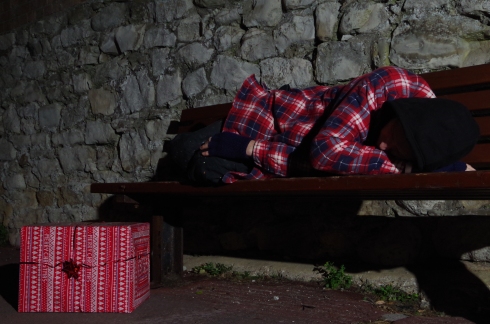
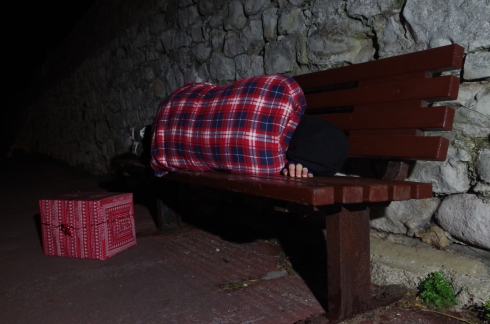
Fifth Location
For the last location I chose a shelter as a background as I felt it enhanced the narrative and made the image look more realistic than the subject laying on a bench.

I had the issue of the reflection of the flash in the window which produced a distracting element to the image. Therefore I had to adjust the height at which the flash was held as well as the angle I captured the image.


Final location
to explore the theme of Christmas and loneliness I decided to take a set of images in front of a Church Christmas display. I felt this would help to give symbolism to the image with underlying meanings related to biblical references of christmas narratives, which is something homeless people may warm to when alone.


Edits
Using both Lightroom and Photoshop, I followed Lee’s process to enhance and improve the quality of my images. I found the process time consuming however, each edit is definitely more aesthetically pleasing.
Edit 1



Edit 2


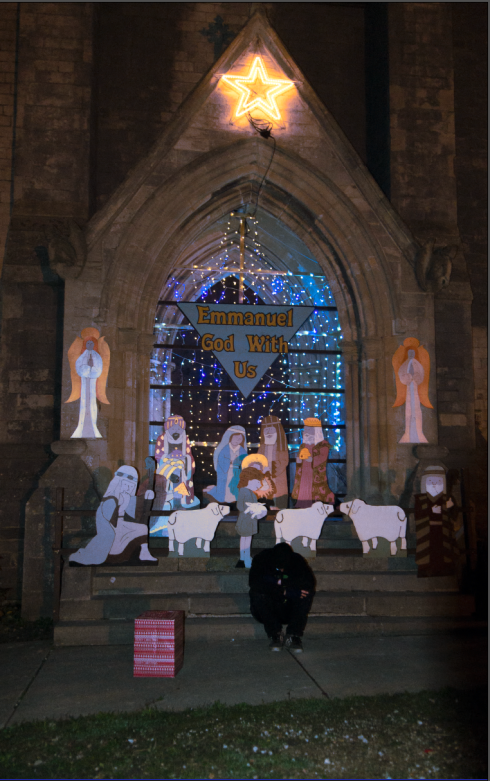
Second shoot
For my second shoot, I went to more locations to enhance the narrative and further develop my ideas. The contact sheet is below.

For my first shot I decided to take an image of the subject sat next to a bus stop, taking the location inspiration from Julien Tatham. I then had the idea that I could manipulate the image in photoshop and edit an ad on the billboard to further enhance the idea.
Edits
I edited the image below by adjusting the contrast and brightness. I explored editing it on Photoshop to make an advert in the billboard relating to the narrative. However, i felt that it didn’t really work as it looked too edited and kind of ruined the ‘open narrative’ feel to my images.



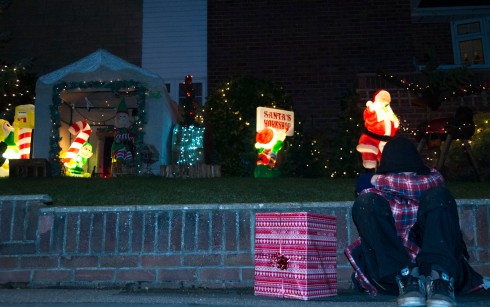
For all of these edits I decided to use a cold filter (white balance) to them link with the emotions of the subject, feeling cold, depressed and sad. For this shot I didn’t actually use the Metz flashgun, but instead use the camera flash to add a dramatic effect to the image. For the last shot in particular I focused on rule of thirds to ensure the subject didn’t dominate the centre of the image. I also experimented with camera angle, using a low vantage point to make the viewer feel as if they are on the same level as the subject, making them connect more with the image.
Layout ideas:
Below I created a powerpoint showcasing my best edits in a sequence. I feel the images work well together to narrate the story, however maybe on set looks best. I feel the second set are the strongest as each of the images are similar in colour therefore work well when placed next to each other.


Evaluation
Overall, I felt like this shoot was successful and I am really pleased with the narrative I chose as I feel its current and realistic as a global issue. I believe I chose a subject well and feel as if the images are believable to the viewer. I feel like my technical skills have definitely improved through experimenting with flashguns as a creative choice of working. I feel like my styling of the shoot in terms of clothing, location and props was successful. My choice of shooting at night was also a creative choice, allowing me to explore the use of flash within my images and to add more of an emotion to the image. To improve, I would perhaps vary my images by either changing the type of prop or even subject if able to.
Critique feedback
In the critique we discussed the context of my work, being as an advertising or awareness campaign no homeless people during Christmas. We discussed that I could perhaps do some edits of my images inside of billboards to add a context and end user considerations. Lauren even showed me a campaign website called Adot, which is a campaign to raise awareness of the 93,000 homeless people all over the UK.









































